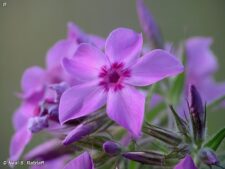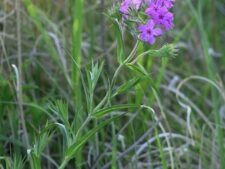
This native, erect, perennial grows from 1 to 2 feet tall. Opposite, stalkless, narrow leaves with pointed tips are up to 4 inches long with soft hairs, especially along the margins and midrib (C). From 12-50 individual flowers form a showy, rounded cluster (panicle) at the tip of the stem or branches (A). The narrow, tubular flower flares outward at the tip into 5 petal-like lobes 3/4 inch across (B). They are typically deep pink with a darker magenta spot at the base, but color varies widely from white to lavender. The fruit is a small capsule seldom seen intact; “exploding” as it matures and dries, thereby dispersing the seeds.
Grows in dry to moist, well-drained prairies and woodland openings, flowering from May through July. At Neale Woods it is rare. Only a few plants are present along Tallgrass Prairie Trail in Knull Prairie.
A plant less than 2 feet tall with pink tubular flowers in an open, sunny location is most likely Prairie Phlox. Fall Phlox (Phlox paniculata) also has pink flowers but it is a more robust plant 3-8 feet tall, which prefers shadier sites and flowers later. Timber Phlox (Phlox divaricata), a woodland species, has blue flowers.
Phlox is derived from the Greek meaning “flame,” likely a reference to its bright colors. Several garden varieties are derived from our native species. Prairie Phlox is also known as Downy or Hairy Phlox.
The content of NatureSearch is provided by dedicated volunteer Naturalists of Fontenelle Forest who strive to provide the most accurate information available. Contributors of the images retain their copyrights. The point of contact for this page is: Neal Ratzlaff.


